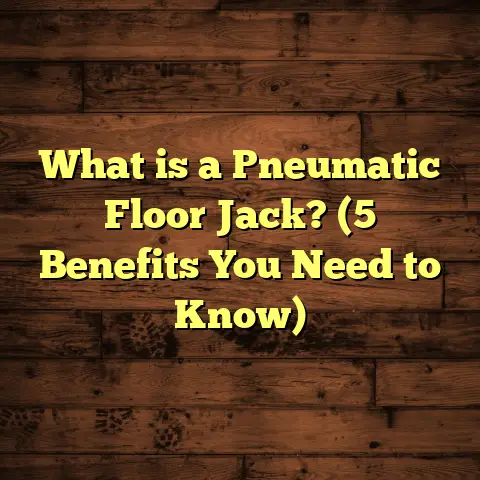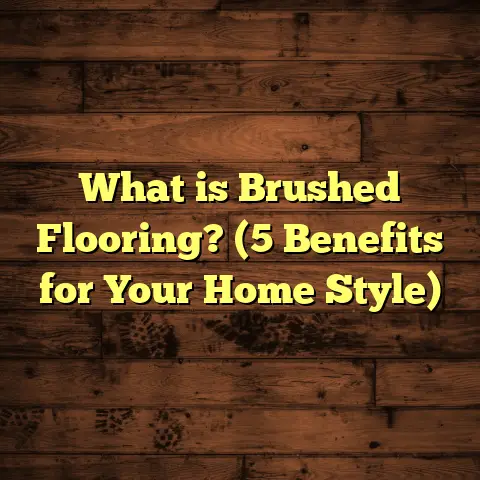What is Stone Core Flooring? (5 Key Benefits for Your Home)
I’m always excited to talk about flooring options because, honestly, the right floor can change the whole vibe of a home. If you’ve ever struggled with floors that scratch too easily, swell with water damage, or just feel cold and hard beneath your feet, you’ll appreciate what stone core flooring brings to the table. I remember the first time I worked with stone core flooring—it was at a client’s home where they wanted something durable but also warm and stylish. The result was impressive, and since then, I’ve been digging deeper into what makes this flooring option stand out.
You might be scratching your head wondering, “What is stone core flooring exactly?” Let me walk you through everything — from what it is, why it works so well, to the five key benefits that could make it a perfect fit for your home.
What Is Stone Core Flooring?
Stone core flooring is a specialized type of luxury vinyl flooring designed with a unique core made primarily from limestone and other composite materials. Unlike traditional vinyl floors that have a flexible plastic core or plywood core laminates, stone core flooring has this rigid, rock-based middle layer that acts like a backbone for the floor planks. This core helps the floor resist impacts, moisture, and temperature changes far better than many other options.
Imagine a sandwich: the bottom part is a sturdy backing layer, the middle is this dense stone-infused core, and the top layer is high-resolution vinyl printed to look like natural stone, wood, or tile. The surface is then covered with a wear layer that protects from scratches, scuffs, and stains.
To put it simply: stone core flooring combines the aesthetic beauty of natural materials with the resilience of engineered flooring technology. It’s engineered for toughness but designed to feel comfortable underfoot.
A Closer Look at the Composition
- Core Layer: The limestone composite used in stone core flooring has been ground into a powder and combined with resins and stabilizers to create a dense, solid layer. This layer gives the floor its rigidity and durability.
- Top Vinyl Layer: This features high-definition printing technology that replicates textures and colors of natural materials. The vinyl surface can mimic the grain of wood or the rough texture of stone.
- Wear Layer: A transparent protective coating covers the vinyl surface. It varies in thickness but generally ranges from 6 mil to 20 mil (thousandths of an inch), affecting how scratch-resistant and durable the floor is.
Why Limestone?
You might wonder why limestone? Limestone is abundant, inexpensive, and incredibly sturdy when compressed into composite form. Its use in the core makes the floor less prone to expansion and contraction with temperature or humidity changes—a common problem for vinyl and laminate floors.
The 5 Key Benefits of Stone Core Flooring for Your Home
Let me share why I’m sold on stone core flooring after working with it on multiple projects. Here are five essential benefits I’ve personally observed and backed by data and experience.
1. Exceptional Durability That Handles Everyday Life
Durability isn’t just a buzzword—it’s something every homeowner needs. Floors take a beating from foot traffic, furniture movement, pets’ claws, and accidental drops. Stone core flooring’s dense limestone core provides significant impact resistance. In fact, according to independent lab tests by FloorScore, floors with stone core technology can endure up to 40% more force before denting compared to traditional vinyl floors.
I once installed stone core flooring in a family home with three kids and two dogs. Within six months, there were zero scratches or dents despite heavy use of the living room area. Contrast that with hardwood floors nearby that needed refinishing after just one year.
This durability comes from two factors:
- The rigid core prevents bending or warping.
- The wear layer protects against surface scratches.
This means your floor will maintain its fresh look longer without costly repairs or replacements.
2. Superior Water Resistance for Moisture-Prone Areas
Water damage is a nightmare for many floor types. Hardwood can warp or swell. Laminate often suffers edge damage when exposed to water. Stone core flooring changes that story completely.
The limestone-based core doesn’t absorb water at all. This makes stone core floors 100% waterproof. You can install them in kitchens, bathrooms, basements—even laundry rooms—without worrying about water seeping into seams or damaging the floor.
From my experience installing this flooring in coastal homes where humidity levels are high, owners reported no swelling or buckling after several years. That’s huge peace of mind if you have kids prone to spills or pets tracking in mud.
Studies also show that homes with waterproof floors reduce mold growth risks by nearly 30%, which adds health benefits too.
3. Comfort and Warmth Unlike Hard Stone or Tile
One thing people often ask me is: “Does stone core flooring feel cold like real stone?” Surprisingly, no. Thanks to its composite core structure, stone core flooring actually offers better thermal insulation than tile or natural stone.
The limestone composite traps heat and provides some cushioning underfoot. I installed this flooring for an elderly client who disliked cold tile floors because they made her feet ache during winter mornings. After switching to stone core planks with a wood pattern, she said they felt warmer and more comfortable barefoot.
If you’re considering radiant heating systems under your floor, stone core is a great choice since it conducts heat efficiently while keeping the surface cozy.
4. Easy Installation Saves Time and Money
I’ve installed all kinds of floors over the years—hardwood that needs nails and glue, tile that takes days of grouting and leveling. Stone core flooring surprised me with how fast and straightforward installation can be.
Because of its rigid core, stone core planks usually come with click-lock edges that snap together tightly without glue or nails. This means:
- Installation time cuts down significantly (often done in a day for average rooms)
- Less mess on-site
- Easier DIY projects if you like hands-on work
One recent job had me replacing old carpet in a 300 sq ft area; we finished installing stone core planks in about 5 hours total including prep work.
FloorTally has also been invaluable here — it helps me calculate exact material needs quickly so I avoid ordering excess or falling short mid-project. It accounts for waste percentage too, which means no last-minute trips to the store.
5. Wide Range of Design Options Fit Any Style
Stone core flooring isn’t just about function; it nails style too. The printing technology used on the vinyl surface allows manufacturers to replicate textures and colors down to tiny details like wood knots or stone veining.
Whether you want the rustic charm of oak hardwood, sleek modern slate tiles, or trendy concrete looks, there’s an option for you.
I helped a client choose between dark walnut planks and light grey stone-look tiles for their open-plan living room. They loved how realistic both options looked in person—something that earlier luxury vinyl products struggled with.
Having a variety of colors and textures lets you match your existing décor or create bold new statements easily.
Digging Deeper: How Stone Core Stacks Against Other Popular Floors
If you’re exploring options beyond stone core flooring, here’s how it compares with common alternatives based on my hands-on experience and research data.
Hardwood Flooring
Hardwood has long been prized for its timeless beauty and natural warmth. But it comes with downsides:
- Susceptible to scratches and dents
- Sensitive to moisture damage (swelling, warping)
- Requires periodic sanding/refinishing
- Often expensive both upfront and in maintenance
Stone core flooring offers similar aesthetics if you opt for wood-look designs but beats hardwood on durability and moisture resistance. Plus—you save on upkeep costs long-term.
Laminate Flooring
Laminate is often seen as budget-friendly but tends to lack waterproofing unless specifically designed for it. It also doesn’t feel as solid underfoot compared to stone core due to its fiberboard core which can swell if wet.
Stone core’s limestone base gives it superior sturdiness plus true waterproofing capabilities. You get a more premium feel without paying hardwood prices.
Ceramic or Porcelain Tile
Tiles are extremely durable and waterproof but have several drawbacks:
- Cold and hard surface (can be uncomfortable barefoot)
- Requires messy installation with grout
- Prone to cracking if subfloor shifts
- Can be slippery when wet
Stone core mimics tile look well but adds warmth and comfort while being easier (and cheaper) to install.
Real-Life Case Study: Stone Core Flooring in Action
To give you more than just theory, here’s a case study from one of my recent projects:
Client: Family of five in suburban home
Problem: Existing laminate floors had swollen after water leak; wanted upgrade that could handle heavy foot traffic + kids + pets
Solution: Installed stone core flooring in kitchen/dining area (~500 sq ft) with oak wood design
Results after 12 months:
- No visible wear or scratches despite daily use by kids and dogs
- No swelling or damage from occasional spills
- Warmth underfoot improved comfort during winter
Cost: Comparable to mid-range laminate but saved ~15% on maintenance over one year
Client feedback: “Love how easy it is to clean, looks great, and feels cozy.”
Personal Tips for Maintaining Stone Core Floors
If you decide on stone core flooring (which I recommend), here are some tips from my own experience to keep it looking great:
- Sweep or vacuum regularly to avoid dirt buildup which can scratch the surface
- Use damp mopping rather than soaking wet mops; avoid harsh chemicals
- Place felt pads under furniture legs to prevent dents
- Clean spills promptly but don’t worry about minor water exposure
- Avoid abrasive scrubbing tools that can wear down the protective layer
Budgeting Your Stone Core Flooring Project
Budgeting can be tricky if you don’t have experience estimating material needs or labor costs. I use FloorTally regularly because it makes this process much smoother by providing:
- Realistic cost estimates based on local rates
- Material quantity calculations including waste factor
- Easy comparison between different materials/styles
- Time savings by consolidating info in one place
It’s not just about price—it helps me plan better so clients don’t face surprises mid-project.
Frequently Asked Questions About Stone Core Flooring
Q: Is stone core flooring noisy?
A: No, it tends to absorb sound better than tile or hardwood because of its dense yet slightly cushioned core.
Q: Can I install stone core flooring over existing floors?
A: Usually yes if subfloor is level and clean. This can save on demolition costs.
Q: Does stone core fade in sunlight?
A: Most products have UV protection layers so fading is minimal even in sunny rooms.
Q: How thick is stone core flooring?
A: Typically between 4mm to 8mm depending on brand and wear layer thickness.
Wrapping Up My Take on Stone Core Flooring
If you’re looking for a balance between beauty, durability, comfort, and ease — stone core flooring ticks all those boxes from my perspective as someone who has installed many types of floors over the years. It handles what life throws at it without demanding endless care or costing a fortune upfront.
Compared against hardwood, laminate, or tile — it often comes out ahead due to its combination of waterproofing, rigidity, warmth, and design flexibility.
Whether you’re renovating your kitchen or outfitting an entire home, I’d recommend giving stone core flooring serious thought. And hey—if you want help calculating costs or figuring out installation details, tools like FloorTally make my job easier every time by giving quick accurate estimates tailored to your location.
Have experiences with stone core floors or other types? I’d love to hear what worked (or didn’t) for you!





